
King Boris III of Bulgaria, left, met with Adolf Hitler during Word War II. Boris refused to declare war on Russia and died soon after from a suspicious “heart attack” at the age of 49.
By: Phil Kohn. Dedicated to the memory of his father, GM3 Walter Kohn, U.S. Navy Armed Guard, USNR, and all men and women who have answered the country’s call in time of need. Phil can be contacted at ww2remembered@yahoo.com.
On August 27, U.S. Marines retake Vella Lavella, Solomon Islands. Arundel Island, also in the Solomons, is reported secured as well. U.S. troops land on Nukufetau, an atoll in the Ellice Islands. In the Bay of Biscay, off western France, the Royal Navy sloop HMS Egret is the first ship to be sunk (with the loss of 194 of its crew) by a guided missile. The newly developed Henschel Hs 263 is a radio-controlled glide bomb with a rocket engine attached that is launched from a bomber. The success of the attack causes the Royal Navy to withdraw anti-submarine patrols from the area.
King Boris III of Bulgaria (which is aligned with the Axis) dies under mysterious circumstances at the age of 49 on August 28. Some conspiracy theorists maintain he was poisoned by the Germans, who may have wanted a more-compliant ruler, while others opine that he was poisoned by the Communists for his collaboration with the Nazis. The official cause of death is listed as “heart attack.” Boris’s six-year-old son takes the throne as King Simeon II; Prime Minister Bogdan Filov is named as regent. In Scandinavia, the Danish government receives a German ultimatum to “do more,” including establishing the death penalty, as a sabotage campaign by the Danish Resistance reaches a crescendo. In response, the Danish government resigns en masse.
The German Army on August 29 occupies Copenhagen, Denmark, declares martial law, arrests Prime Minister Erik Scavenius and confines King Christian X to his palace. As this is being done, the Royal Danish Navy scuttles 32 vessels of its fleet, leaving only a few small craft to be taken by the Germans. Some vessels escape to neutral Sweden.
An air battle between 44 USAAF P-38s and 75 Luftwaffe fighters occurs above Italy on August 30. The P-38s are escorting a large formation of B-26s on their way to bomb railroad marshalling yards at Aversa, about three miles north of Naples. The Americans lose 13 P-38s but shoot down 9 Axis aircraft. The fighter action allows the bombers to make an unmolested run to their target, where they cause extreme damage without loss. In Germany, the Ministry of Transport forbids non-business use of horse-drawn vehicles, mandating their use only in “work of war importance.”
The Japanese submarine I-8 reaches France on August 31 after a marathon voyage from Penang, Malaya. In Germany, the RAF again pounds Berlin: over 600 bombers drop more than 1,000 tons of ordnance, killing about 5,000 civilians. In Eastern Europe, Hitler allows Field Marshal Erich von Manstein, commander of Army Group South, to make limited withdrawals in the Ukraine. In the Pacific, the Grumman F6F Hellcat fighter — flown from aircraft carriers by Navy and Marine Corps pilots — makes its combat debut. (Of the 6,477 Japanese aircraft that U.S. carrier-based pilots claimed to have destroyed during the war, the Hellcat was responsible for 4,979 [77%] of them.)
On September 1, 1943, U.S. troops occupy Baker Island, just north of the Equator in the Pacific, roughly halfway between Hawaii and Australia.
The neutral Swedish ocean liner MS Gripsholm on September 2 departs from Jersey City, New Jersey, for Mormugao, Goa, Portuguese India, carrying 1,330 Japanese citizens stranded in the U.S. when the war broke out. By an agreement between the U.S. and Japan, the Japanese ship Teia Maru will bring 1,525 civilians of American and other nationalities similarly stranded in Japan to Mormugao, where an exchange will take place on October 15, 1943.


